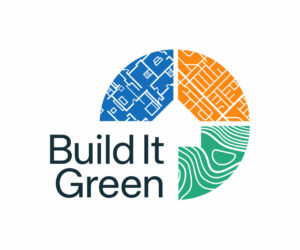INFRASTRUCTURE OPPORTUNITY WORKING GROUP
Infrastructure Principles and Aspirations
By: Lara Isaacson, Program Manager
Last December, Build It Green hosted the Building Our Future meetings, which brought together advocates, designers, builders, and decision-makers committed to addressing the interwoven challenges of equity, the environment, and housing affordability in California. Through these meetings, attendees identified several topic areas that could benefit from cross-sector collaboration, and four working groups were formed. The “Reporting Out” series shares some of the developments and activities resulting from their efforts.
August 2, 2022
During this unique infusion of federal and state funding for infrastructure projects, the Infrastructure Opportunity Working Group sees an opportunity to build and maintain infrastructure in ways that promote equitable, climate-conscious, and community-centered housing development without sprawl. Typically, infrastructure is thought of as roads, pipes, and other elements of the built environment that connect our homes, workplaces, and shops to municipal services and each other. Yet, if infrastructure is what provides access to resources needed for survival, then housing (equitable access to which is one of the biggest issues we face today), broadband, parks, and ecosystem services should also qualify. Rather than exacerbating challenges brought on by crises like climate change, drought, and displacement, infrastructure can and should be used as an instrument to reduce our carbon footprint, conserve resources, and protect California’s most vulnerable communities and people.
How the Principles Were Created
Reframing our definition of infrastructure to include and support housing and communities was an idea brought up during the Building Our Future meetings and prioritized by attendees to be covered in a working group. If housing is actually a form of infrastructure and the priority for infrastructure investment is to make communities equitable and environmentally friendly, then these understandings should be reflected in funding pipelines. Raising questions about what infrastructure is, as well as who and what it should serve, led to a rich dialogue within the group; the principles were proposed as a way to capture these insights and foster alignment between working group members and others engaged in infrastructure decision-making.
What the Principles Are and Are Not
The ‘Infrastructure and California’s Communities Principles’ are a result of the working group’s collective efforts to guide its next phase of work and to help articulate aspirations for everyone involved in California infrastructure issues. However, this initial version of the principles is not meant to be a static checklist. It is a living document that will evolve with the work. The working group hopes the principles will be a conversation starter and encourage holistic thinking as work around California’s infrastructure unfolds in the months and years ahead.
Here is what a couple of the participants in the Infrastructure Opportunity Working Group had to say about the principles:
These principles are an important step in aligning the green building community around a holistic vision of what it means not just to develop a green building in isolation, but to pursue environmentally friendly infrastructure and land use patterns that allow people to thrive.
Joanna Gubman, Executive Director,
Urban Environmentalists
I think that this statement of principles is outstanding and provides an excellent road map for the work ahead.
Bill Lindsay, Former City Manager of the City of Richmond Tweet
Image courtesy of benedek on iStock.

